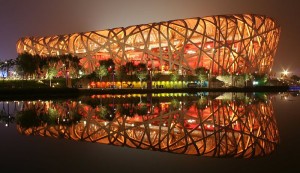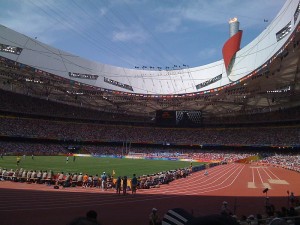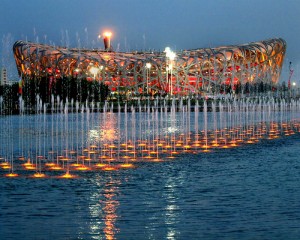#30. Olympic Stadium (The Bird’s Nest)
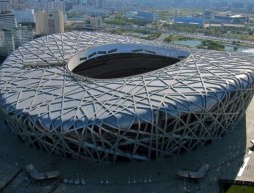
China Beijing Olympic National Stadium
 Olympic Stadium (The Bird’s Nest) Location: Beijing, China Architect: Herzog & de Meuron Year: 2008
Olympic Stadium (The Bird’s Nest) Location: Beijing, China Architect: Herzog & de Meuron Year: 2008
This stadium might be the only thing we remember from the 2008 Beijing Olympics. Swiss firm Herzong & de Meuron looked to traditional Chinese ceramics for inspiration and employed iconic contemporary artist Ai Weiwei as artistic consultant. One of the few sporting venues that truly stands as symbol of a city.
Beijing National Stadium, officially the National Stadium (Chinese: 國家體育場; pinyin: guójiā tǐyùchǎng), also known as the Bird’s Nest (鸟巢 Niǎocháo), is a stadium in Beijing, China. The stadium was designed for use throughout the 2008 Summer Olympics and Paralympics.
History
Located at the Olympic Green, the stadium cost US$423 million. The design was awarded to a submission from the Swiss architecture firm Herzog & de Meuron in April 2003 after a bidding process that included 13 final submissions. The design, which originated from the study of Chinese ceramics, implemented steel beams in order to hide supports for the retractable roof; giving the stadium the appearance of a bird’s nest. Leading Chinese artist Ai Weiwei was the artistic consultant on the project. The retractable roof was later removed from the design after inspiring the stadium’s most recognizable aspect. Ground was broken on 24 December 2003 and the stadium officially opened on 28 June 2008. A shopping mall and a hotel are planned to be constructed to increase use of the stadium, which has had trouble attracting events, football and otherwise, after the Olympics.
Bidding
In 2001, before Beijing had been awarded the right to host the 2008 Summer Olympics, the city held a bidding process to select the best arena design. Multiple requirements including the ability for post-Olympics use, a retractable roof, and low maintenance costs, were required of each design. The entry list was narrowed to thirteen final designs. Of the final thirteen, Li Xinggang of China Architecture Design and Research Group (CADG), said after he placed the model of the “nest” proposal at the exhibition hall and saw the rival entries he thought to himself, “We will win this.” The model was approved as the top design by a professional panel; however, it was later exhibited for the public. Once again, it was selected as the top design. The “nest scheme” design became official in April 2003.
Design and construction
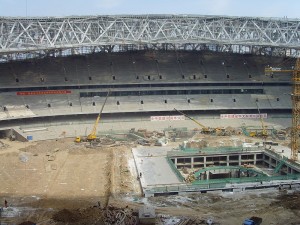 Under construction in September 2007
Under construction in September 2007
Why does a Chinese bowl or a Chinese window have this kind of pattern? Maybe the Chinese people like things to appear in this irregular way, but underneath there are very clear rules. The Bird’s Nest developed in this way.
— Li Xinggang, head architect of CADG
Beijing National Stadium (BNS) was a joint venture among architects Jacques Herzog and Pierre de Meuron of Herzog & de Meuron, project architect Stefan Marbach, artist Ai Weiwei, and CADG which was led by chief architect Li Xinggang. During their first meeting in 2003, at Basel, the group decided to do something unlike Herzog and de Meuron had traditionally designed. “China wanted to have something new for this very important stadium,” Li stated. In an effort to design a stadium that was “porous” while also being “a collective building, a public vessel,” the team studied Chinese ceramics. This line of thought brought the team to the “nest scheme.” The stadium consists of two independent structures, standing 50 feet apart: a red concrete seating bowl and the outer steel frame around it.
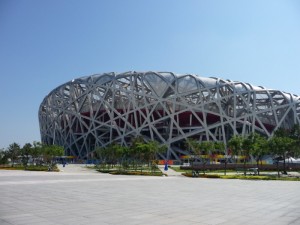 In an attempt to hide steel supports for the retractable roof, required in the bidding process, the team developed the “random-looking additional steel” to blend the supports into the rest of the stadium. Twenty-four trussed columns encase the inner bowl, each one weighing 1,000 tons. Despite random appearance, each half of the stadium is nearly identical. After a collapse of a roof at the Charles de Gaulle International Airport, Beijing reviewed all major projects. It was decided to eliminate the retractable roof, the original inspiration for the “nest” design, as well as 9,000 seats from the design. The removal of the elements helped to bring the project under the reduced construction budget of $290 million, from an original $500 million. With the removal of the retractable roof, the building was lightened, which helped it stand up to seismic activity; however, the upper section of the roof was altered to protect fans from weather. Enerpac was granted the contract to perform the stage lifting and lowering of the stadium roof as part of the construction process. Due to the stadium’s outward appearance, it was nicknamed “The Bird’s Nest”. The phrase was first used by Herzog & de Meuron, though the pair still believes “there should be many ways of perceiving a building.” The use is a compliment Li explained, “In China, a bird’s nest is very expensive, something you eat on special occasions.”
In an attempt to hide steel supports for the retractable roof, required in the bidding process, the team developed the “random-looking additional steel” to blend the supports into the rest of the stadium. Twenty-four trussed columns encase the inner bowl, each one weighing 1,000 tons. Despite random appearance, each half of the stadium is nearly identical. After a collapse of a roof at the Charles de Gaulle International Airport, Beijing reviewed all major projects. It was decided to eliminate the retractable roof, the original inspiration for the “nest” design, as well as 9,000 seats from the design. The removal of the elements helped to bring the project under the reduced construction budget of $290 million, from an original $500 million. With the removal of the retractable roof, the building was lightened, which helped it stand up to seismic activity; however, the upper section of the roof was altered to protect fans from weather. Enerpac was granted the contract to perform the stage lifting and lowering of the stadium roof as part of the construction process. Due to the stadium’s outward appearance, it was nicknamed “The Bird’s Nest”. The phrase was first used by Herzog & de Meuron, though the pair still believes “there should be many ways of perceiving a building.” The use is a compliment Li explained, “In China, a bird’s nest is very expensive, something you eat on special occasions.”
Ground was broken, at the Olympic Green, for Beijing National Stadium on 24 December 2003. At its height, 17,000 construction workers worked on the stadium. Portraits of 143 migrant workers at the construction site were featured in the book Workers (Gong Ren) by artist Helen Couchman. On 1 January 2008, The Times reported that 10 workers had died throughout construction; despite denial from the Chinese government. However, in a story the following week, Reuters, with the support of the Chinese government, reported that only two workers had died. All 110,000 tons of steel were made in China. On 14 May 2008 the grass field of 7,811 square meters was laid in 24 hours. The field is a modular turf system by GreenTech ITM. Beijing National Stadium officially opened at a ceremony on 28 June 2008.
Features and events
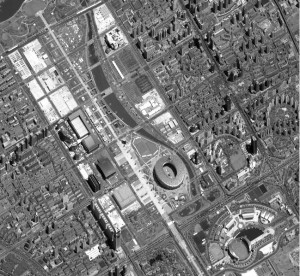 Satellite image of the stadium
Satellite image of the stadium
The eastern and western stands of Beijing National Stadium are higher than northern and southern stands, in order to improve sightlines. A 24-hour per day rainwater collector is located near the stadium; after water is purified, it is used throughout and around the stadium. Pipes placed under the playing surface gather heat in the winter to warm the stadium and coldness in the summer to cool the stadium. The stadium’s design originally called for a capacity of 100,000 people; however 9,000 were removed during a simplification of the design. The new total of 91,000 would be shaved further when 11,000 temporary seats were removed after the 2008 Olympics; bringing the stadium’s capacity to 80,000. The farthest seat is 460 feet (140 meters) from center field. Temperature and airflow of every surface were optimized to increase ventilation.
Beijing National Stadium hosted the Opening and Closing Ceremonies, athletic events, and football final of the 2008 Summer Olympics from 8 to 24 August 2008. The stadium also hosted the Opening and Closing ceremonies and athletic events of the2008 Summer Paralympics from 6 to 17 September 2008. Though designed for track & field events of the Olympics, the stadium will continue to host sporting events, such as football, afterwards. A shopping mall and a hotel, with rooms overlooking the field, are planned to help increase use after the Olympics. Li stated, “This will become the most important public space in Beijing.”
Inside of the stadium during the 2008 Summer Olympics
Post-Olympics
On the first anniversary, 8 August 2009, the stadium hosted a performance of the opera Turandot, and the 2009 Supercoppa Italiana (Italian Super Cup) final, the traditional curtain raiser to the Italian football league season. The Beijing Guo’an football club was scheduled to play at the stadium, but later backed out of their agreement, citing the embarrassment of using an 80,000+ seat venue for games that routinely draw only slightly more than 10,000.
On 12 January 2009 the venue’s owners announced plans for the stadium to anchor a shopping and entertainment complex. These plans, being developed by operator Citic Group, are projected to take three to five years to achieve. The stadium will also continue to function as a tourism attraction, while seeking sports and entertainment events.
2008 Summer Olympics flame
The stadium hosted the 2009 Race of Champions. In July 2010, the stadium hosted a friendly football match between Football League Championship team Birmingham City and Beijing Guoan as a part of Birmingham’s pre-season trip to China, homeland of the club’s owner Carson Yeung. Birmingham City recorded a 1-0 victory in the game.
In spite of the lack of significant events, the stadium appears to be quite profitable, drawing some 20,000 to 30,000 people a day at the price of a 50 yuan admission. Recently it has been used as a snow theme park. The venue costs approximately$9 million to maintain per year. Due to a lack of use, paint is already peeling in some areas.
On 1 November 2010 the IAAF announced that the 2015 World Championships in Athletics will take place at the Beijing National Stadium.
In August 2011, the Bird’s Nest once again hosted the Supercoppa Italiana, the stadium’s second in three years, and it will host it once again in 2012.
Arsenal FC and Manchester City FC played each other in the inaugural ‘China Cup’, a one-off match in Beijing’s the stadium played on Friday, 27 July 2012. Manchester City FC won the match with a score of 2-0.
American-Taiwanese pop star Leehom Wang held the first solo pop concert at the stadium on April 14, 2012.
Korean pop artist under S.M. Entertainment including Kangta, BoA, TVXQ, Super Junior (Super Junior-M), Girls’ Generation,SHINee, f(x), EXO, Zhang Liyin, and Tasty will perform at the stadium for the first time on October 19, 2013 as part of the SMTown Live World Tour III.

